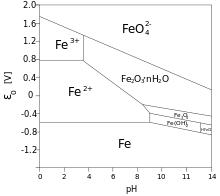Ferrous
_oxide.jpg)
In chemistry, ferrous (Fe2+), indicates a divalent iron compound (+2 oxidation state), as opposed to ferric, which indicates a trivalent iron compound (+3 oxidation state).[1] This usage has decreased, with current IUPAC nomenclature having names containing the oxidation state in bracketed Roman numerals instead, such as iron(II) oxide for ferrous oxide (FeO), and iron(III) oxide for ferric oxide (Fe2O3).

Outside chemistry, ferrous indicates the presence of iron.[1] The word is derived from the Latin word ferrum ("iron").[2] Ferrous metals include steel and pig iron (with a carbon content of a few percent) and alloys of iron with other metals (such as stainless steel). Manipulation of atom-to-atom relationships between iron, carbon, and various alloying elements establishes the specific properties of ferrous metals.[3] Non-ferrous metals and alloys do not contain an appreciable amount of iron.[4]
See also
- Ferromagnetism
- Steelmaking
- Ferrous metal recycling
- Iron(II) oxide (ferrous oxide)
- Iron(II) bromide (ferrous bromide)
References
| Look up ferrous or nonferrous in Wiktionary, the free dictionary. |
- 1 2 Ferrous, Merriam-Webster, retrieved 19 April 2008 .
- ↑ Etymology (Meaning of Words), 30 November 2007, retrieved 19 April 2008 .
- ↑ "Ferrous Alloys Properties". All Metals & Forge Group. Retrieved 1 October 2013.
- ↑ Non ferrous, Merriam-Webster, retrieved 19 April 2008 .